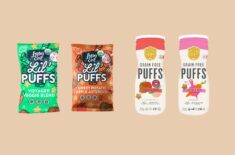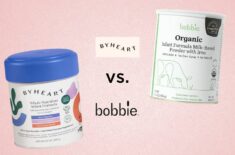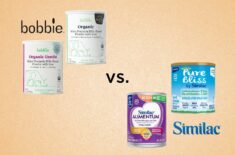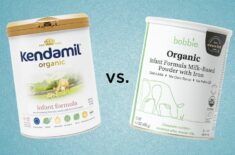What Is BLW?
Baby-led weaning (BLW) skips traditional purée spoon-feeding and lets your baby take the lead in feeding themselves with appropriately-sized finger foods. However, not all babies are suitable for BLW. Some babies may be ready while others may take time, it’s okay. Each baby will learn milestones at their own pace.
What Should A Baby Eat For Breakfast?
Breakfast is often dubbed the most important meal of the day. You can give your baby varied but balanced and nutritious foods to help them jumpstart their day.
Whenever possible, choose non-GMO and/or whole organic foods. You can also go for options that are minimally processed, refined, or contain minimal additives. It may be best to choose whole foods in their whole form about 80 percent of the time.
When thinking about balanced meals for your baby you can think of it like this: Does this meal contain protein, fat, and fiber?
Here are the basic components of a healthy breakfast:
Lean protein
- Eggs
- Low-mercury fish (salmon, cod, halibut)
- Skinless poultry (chicken or turkey breast)
- Lean beef and pork meat
- Beans, chickpeas, and lentils
High-quality fats
- Nut butter or peanut butter
- Ghee
- Coconut oil, coconut yogurt
- Avocado
- Unsweetened yogurt, or Greek yogurt
- Low-fat cheese
Fiber sources
- Fruits and veggies like banana, strawberries, apple, and sweet potato
- Quinoa
- Overnight oats
- Whole-grain waffles, mini muffins, or bagels
When introducing allergens to your baby, it can be a good idea to consult your pediatrician or dietitian first.
What Are The Benefits Of A Healthy Breakfast For My Baby?
As your baby starts solid foods, breakfast can be a good opportunity to introduce them to nutrients essential to their growth and development. Here are some benefits your baby can get from regularly eating a good breakfast: (1)
- Your baby can keep up with their daily nutritional needs.
- They are able to maintain their suggested body weight.
- It can also help with your child’s ability to focus and learn.
- It can boost your baby’s energy, making them less tired and irritable.
- Eating a good breakfast can also develop better hand-eye coordination.
What Can I Give My 6-Month-Old Baby For Breakfast?
At six months of age, your baby’s main source of nourishment will still be breastmilk or formula milk. Parents or caregivers shouldn’t worry too much about their baby’s first foods. Breastmilk and formula milk contain all the nutrients your baby needs for proper growth and development until about one year old. (3)
During this stage, solid food mealtimes for your baby are still practice sessions. It helps to let your baby sample a variety of tastes and textures. It’s also beneficial in identifying allergens and for sensory play.
For their first foods, it can be a good idea to give them something soft, cut into large sizes that are easy to grab. Look out for your baby’s cue if they want to eat more.
What Can I Give My 8-Month-Old Baby For Breakfast?
At eight months old, your baby might have already developed its pincer grasp, the ability to hold something between their thumb and first finger. This allows them to hold utensils properly. If your baby still cannot hold a spoon properly, it’s okay. You can let your baby continue practicing by demonstrating how it’s done.
Your baby might be ready to eat two to three meals a day during this age. Many babies also show some front teeth, letting them cut their foods better. Still, it may be best to serve soft foods cut in pieces they can easily grasp.
What Can I Give My 1-Year-Old Baby For Breakfast?
At age one, your baby’s main source of nutrition is now solid foods. You can now share your family’s food with your baby. With their little tummies, you’ll still want to pack them with nutrient-rich foods, so they can go, grow and glow!
Your baby is already an expert at grasping food or using utensils during this stage. If not, don’t worry as each baby develops on their own time. Even if self-feeding is now much easier, it’s still advisable to supervise your baby while eating.
We’ve written a handy guide for more information on BLW foods by age.
No Salt Or Added Sugar
According to experts, there’s no need to add salt or sugar to your baby’s food. Children under two years old should avoid added sugar.Here are the possible negative effects:
- Your baby’s food preferences in childhood might be influenced, resulting in picky eating later on. (4)
- It may increase your baby’s risk of cardiovascular disease later in life. (5)
- It can cause your baby’s blood pressure to rise. (5)
Here are common foods high in added sugars and sodium:
- Flavored milk
- Soft drinks or sodas
- Juice drinks
- Flavored yogurts
- Canned foods
- Processed foods such as bacon, ham, or nuggets
- Snack or store-bought foods high in salt or sugar
10 Quick & Easy BLW Breakfast Food Ideas
Are you excited to start preparing your baby’s food? Or are you scratching your head over whatto serve?
You don’t need to have master chef skills to whip up nutritious homemade BLW food for your little one. Here are a few quick and easy breakfast ideas you can add to your baby’s menu:
Egg Breakfast Recipes
- Omelet Fingers – Eggs are great baby breakfast ideas. Simply add veggies like zucchini, smashed tomato, sweet potato. Once the omelet is thoroughly cooked, cut it into strips for your baby to easily hold.
- Mashed Hard-Boiled Egg Mixed With Yogurt – This is a healthy, yummy way to introduce eggs to your baby. Eggs and yogurt are a good breakfast combination as both are high in protein, good fats, and essential amino acids. (6)
Note: Eggs and yogurt (dairy) are common allergens, so be sure to consult with your pediatrician before introducing either.
- Egg And Spinach Cups – Simply mix eggs, chopped spinach, tomato, and bell peppers. Place on the muffin tin and bake for 20 minutes at 350 F.
- Baby French Toast Sticks – Cut bread into finger strips and dip into an egg batter. Fry on a skillet. You can top it with peanut butter, mashed sweet potato, or anything else.
Egg-Free Breakfast Recipes
- Chia Seed Pudding And Berries – When you don’t have time in the morning, you can prepare a healthy meal the night before. Simple mix chia seeds with coconut milk and unsweetened applesauce. Leave it in the fridge overnight. You can add mashed blueberries or strawberries loaded with fiber and vitamin C.
- Avocado Sweet Potato Toast Sticks – Slice the sweet potato lengthwise into around ¼-inch thick. Top it with mashed avocado. The healthy fats in avocado are good for your baby’s brain development. (7)
- Waffle sticks – Toast frozen waffles and cut them into sticks. Top it with mashed banana and yogurt. If you can, use clean label brands or products that contain natural and simple ingredients, such as Birch Benders.
- Sweet Potato Mash With Ground Pork Breakfast Sausage – Introduce your baby to bolder tastes and textures with mash and sausage. It can also be your baby’s time to practice using a spoon, or they can simply use their hands.
- Banana Breakfast Muffins Or Pancakes – Mash banana, stir in chia seeds, and almond flour or oat flour. You can use dairy-free milk options like oat milk. Mix together and pour in a muffin tin. Bake at 350 F or until golden brown. Cut the muffin in half so it can be the perfect size for your baby to grasp.
- Mini Chickpea Flour Frittatas This frittata uses chickpea flour instead of eggs. Chop broccoli, cauliflower, zucchini, and bell peppers and combine in a bowl. Whisk chickpea flour gradually with water. Mix the vegetables with the chickpea batter. Fill muffin tins and bake at 350 F for 30 minutes.
Useful Tools & Tips
There are essential tools and equipment that you may need for your baby-led weaning recipes:
- Vegetable steamer – Steaming can help retain the vitamins and minerals of fruits and vegetables
- Oven and muffin tins – When making baked goods, it’s a good idea to skip the salt and added sugar.
- Skillet or an air fryer – Poultry meat and eggs need to be thoroughly cooked
- Cookie cutters – When making fun finger foods shapes, it’s still advisable to keep the right and appropriate sizes of foods.
- Ice cube tray or baby food jars – Freeze baby food in ice cube trays. Once frozen, transfer it baby-food jars for single-serving portions.
Brekkie Tips For Daycare Babies
Do you often feel like you’re in a mad rush every morning? Aside from preparing the kids for school or daycare, there are countless to-dos with so little time. There may be mornings when it can be hard to get your children to eat breakfast before heading out the door. You’re not alone in this dilemma.
But a good breakfast is important, and babies should have enough time to enjoy their meals. Here are practical suggestions that can help: (8)
- Meal planning can go a long way. You can prepare and plan your meal the night before. Cut up fruits and vegetables or get the dishes and utensils ready.
- It may be a good idea to stock up on healthy breakfast options that you can easily freeze and reheat.
- Keeping a list of meal ideas can also help you plan your meals.
- It can also help if you have “ready-to-go” foods during extra busy times.
- Eating in the car can be a choking hazard. It may be best if you get everyone up 10 minutes earlier, so you can all sit down for breakfast together.
- You can also inquire with your daycare provider if they can offer breakfast. You can also see if it’s possible to send a packed breakfast for your baby to eat as soon as they arrive at the daycare center.
FAQS
1. Is My Baby Ready For Baby-Led Weaning?
Baby-led weaning is not suitable for all babies, that’s okay. All babies are unique and develop on their own time. Here are signs of readiness to consider if your baby is ready:
- Sits on their own with no support
- Shows strong head and neck control
- Displays interest when you offer food, they open their mouth or attempt to grab
- Your baby swallows the food rather than spit it out
- You baby can already move food from the front of their mouth to the back to swallow
2. What Can I Give My Weaning Baby For Breakfast?
The AAP (American Academy of Pediatrics) says that most babies don’t need a strict food guide. In choosing the best foods to give your baby, you can offer options from different food groups. This way, your baby explores new tastes and flavors and gets the crucial nutrients they need to grow. (9)
3. How Many Times A Day Should You Do Baby-Led Weaning?
Since your baby takes the lead in BLW, it’s important to recognize your baby’s cues. Get your baby comfortable eating solid foods by introducing small portions once a day. Gradually increase the frequency of feedings once you notice he is ready to eat more.
4. How Do I Prepare For Baby-Led Weaning?
To help ensure your baby’s safety during baby-led weaning, preparation is the key. We can reduce the risk of choking incidents by knowing how to cut and prepare foods appropriately.
- For cylindrical foods like sausage, you can cut them into strips.
- For round-shaped foods like cherry tomatoes, you can keep the pieces at no bigger than ½ inch. You can also mash them up.
- Hard foods like carrots need to be steamed or cooked until fork tender.
- It can be a good idea for fruits and vegetables to remove the pits and skins.
You might also need to prepare the following tools and equipment during your baby’s feeding time:
- Comfortable high chair
- BPA-free utensils, bowls, and baby cups (we prefer silicone or stainless steel)
- BLW cloth or silicone bibs that are suitable for your baby’s needs
- Messy mat or tray
5. How Common Is Choking In Baby-Led Weaning?
A 2017 research showed no increase in choking incidents with BLW compared to traditional spoon-feeding. (10)
However, experts still advise that parents and caregivers take caution when offering foods that can be choking hazards.
6. What If My Baby Rejects The Food I Made?
You don’t have to force your baby. It’s normal for babies to reject foods that are new to them. It’s a good idea to let your baby explore and get used to new tastes and textures. After five days, you can try introducing the same food again and see if your baby is now willing to give it a try. However, if your baby continually rejects all solids, you might want to contact your pediatrician or dietitian.
REFERENCES
:
- https://www.mayoclinic.org/healthy-lifestyle/nutrition-and-healthy-eating/in-depth/food-and-nutrition/art-20048294
- https://www.mayoclinic.org/healthy-lifestyle/infant-and-toddler-health/in-depth/healthy-baby/art-20046200
- https://www.healthychildren.org/English/ages-stages/baby/breastfeeding/Pages/Working-Together-Breastfeeding-and-Solid-Foods.aspx
- https://www.ncbi.nlm.nih.gov/pmc/articles/PMC6520717/
- https://pubmed.ncbi.nlm.nih.gov/32259824/
- https://health.clevelandclinic.org/what-are-the-best-sources-of-protein/
- https://www.ncbi.nlm.nih.gov/pmc/articles/PMC4882728/
- https://doh.health.tas.gov.au/healthykids/blog/the_breakfast_and_daycare_dilemma
- https://www.cdc.gov/nutrition/infantandtoddlernutrition/foods-and-drinks/when-to-introduce-solid-foods.html .
- https://pubmed.ncbi.nlm.nih.gov/29205569/#affiliation-1












